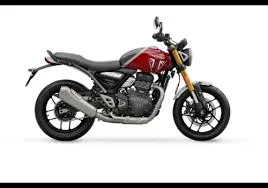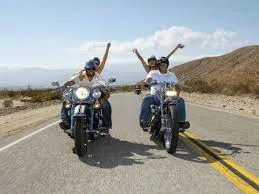 Motorbikes
Motorbikes
The Evolution of Motorbikes: From Classic Rides to Modern Beasts
Feel the Roar of History and the Pulse of Innovation. There’s something incredibly thrilling about a motorbike. The raw engine sound, the rush of air against your face, and the sense of freedom are unlike anything else on the road. But how did we get here—from the classic, rickety rides of the early 1900s to the modern beasts we ride today? This journey isn’t just about machines. It’s about dreams, rebellion, freedom, and innovation. In this blog, we’ll ride through time, exploring how motorbikes have evolved—and why these two-wheeled icons still stir the soul. 1. The Humble Beginnings (Late 1800s - 1930s) It all started with a dream—to put a motor on a bicycle. The first motorbike was created in 1885 by German inventors Gottlieb Daimler and Wilhelm Maybach. It was a wooden frame with a small engine, and while it looked strange, it was the spark that ignited the motorbike revolution. By the 1920s and 30s, brands like Harley-Davidson, Indian, and Royal Enfield emerged, building durable motorcycles that served both civilians and the military. These were the classic rides—not very fast, but full of character. Their engines growled, their parts rattled, and their design was raw and authentic. Riders back then were pioneers, adventurers exploring unpaved roads with nothing but a leather jacket and guts. 2. The Golden Era of Motorbikes (1940s-1970s) After World War II, motorbikes exploded in popularity. Soldiers returned from war with a deep love for motorcycles—they reminded them of freedom and brotherhood. Café racers, cruisers, and choppers became symbols of rebellion and coolness. Think of James Dean, Steve McQueen, and Marlon Brando on their iconic bikes. Motorbikes became cultural icons. During this time: Royal Enfield’s Bullet became the go-to bike in India. Triumph, Norton, and BMW grew rapidly in Europe. Japanese brands like Honda and Yamaha entered the game with affordable, reliable models. Riding a motorbike became a statement—a way to stand out, to be bold, to chase your own path. 3. Speed, Tech, and Global Domination (1980s–2000s) Welcome to the age of performance and technology. Motorbikes transformed from rugged tools into high-speed machines. Innovations like disc brakes, fuel injection, and wind-tunnel designs changed the riding experience. Superbikes emerged—sleek, aggressive, and lightning fast. Brands like Kawasaki Ninja, Suzuki Hayabusa, and Honda CBR gave motorbike lovers a taste of raw power. These bikes weren’t just for commuting—they were for racing, adrenaline, and thrill. In India, the 90s saw the rise of Hero Honda, Bajaj Pulsar, and TVS Apache—bikes that were affordable, stylish, and perfect for the growing middle class. This era was about modern bikes—bikes with powerful engines, modern designs, and improved safety. 4. The Rise of Modern Beasts (2010s–Today) We’re now living in the golden age of motorbikes. Today’s bikes are smart, stylish, and savage. Here’s what makes today’s motorbikes modern beasts: Smart features like Bluetooth connectivity, navigation, ride modes, and ABS. Sleek aerodynamics inspired by racing technology. Electric bikes that are clean, quiet, and surprisingly powerful. Adventure bikes are built for long rides, mountains, and trails. Think of the Ducati Panigale, Royal Enfield Himalayan, KTM Duke, or the futuristic Ultraviolette F77—these are machines with heart and soul. Motorbikes have become more than transport—they’re experiences. They tell stories. They connect people. They empower individuality. 5. Why We Still Love Motorbikes What makes motorbikes so irresistible? It’s not just the speed—it’s the emotion. When you ride a bike: You feel every curve of the road. You connect with the elements. You become part of a story that started over a century ago. Whether it’s a classic Bullet or a modern beast like a Triumph Street Triple, every motorbike whispers the same promise: freedom. Examples of the Evolution Era Example Motorbike Notable Feature 1900s Daimler Reitwagen First motorbike ever 1950s Triumph Bonneville Classic British style 1970s Royal Enfield Bullet 350 Rugged Indian icon 1990s Kawasaki Ninja ZX-11 World’s fastest bike 2000s Yamaha R1 Track-level performance 2020s Ultraviolette F77 Electric, connected, futuristic Conclusion: Ride into the Future The journey from classic rides to modern beasts is more than mechanical—it’s emotional. It’s about passion, power, and progress. As we move toward electric bikes and AI-powered rides, one thing remains constant: our love for motorbikes. That deep, unspoken bond between man and machine. So whether you're riding a vintage Royal Enfield or a cutting-edge Ducati, know this—you're part of a legacy. A rider of dreams. A chaser of freedom. Explore the legacy. Embrace the thrill. And check out our latest motorbike collections and blogs at [https://www.euttaranchal.com/packages/shimla-bike-rentals-347]. 10 FAQs on the Evolution of Motorbikes 1. When was the first motorbike invented?The first motorbike was invented in 1885 by Daimler and Maybach in Germany. 2. What are classic motorbikes known for?Classic bikes are known for their vintage charm, raw mechanics, and timeless designs. 3. How have modern bikes improved over time?Modern bikes feature fuel efficiency, electronic systems, smart features, better safety, and performance. 4. What is a modern beast in terms of motorbikes?A "modern beast" refers to high-tech, high-performance motorbikes with advanced features and sleek designs. 5. Which motorbike brands are most iconic globally?Harley-Davidson, Royal Enfield, Honda, Yamaha, Ducati, Triumph, and BMW are among the most iconic. 6. Are electric motorbikes the future?Yes, electric bikes like Revolt and Ultraviolette are rising in popularity due to their eco-friendliness and innovation. 7. What’s the difference between a cruiser and a sportbike?Cruisers are built for comfort and long rides; sportbikes are designed for speed and agility. 8. How have Indian motorbikes evolved?India moved from British-made classics to homegrown brands like Hero, Bajaj, and TVS, now exploring electric mobility. 9. Is it worth buying a classic bike today?Yes, classic bikes have strong resale value, nostalgic appeal, and a unique riding experience. 10. What makes motorbikes emotionally appealing?They symbolize freedom, adventure, personal expression, and a deep connection between rider and machine.
Read More




